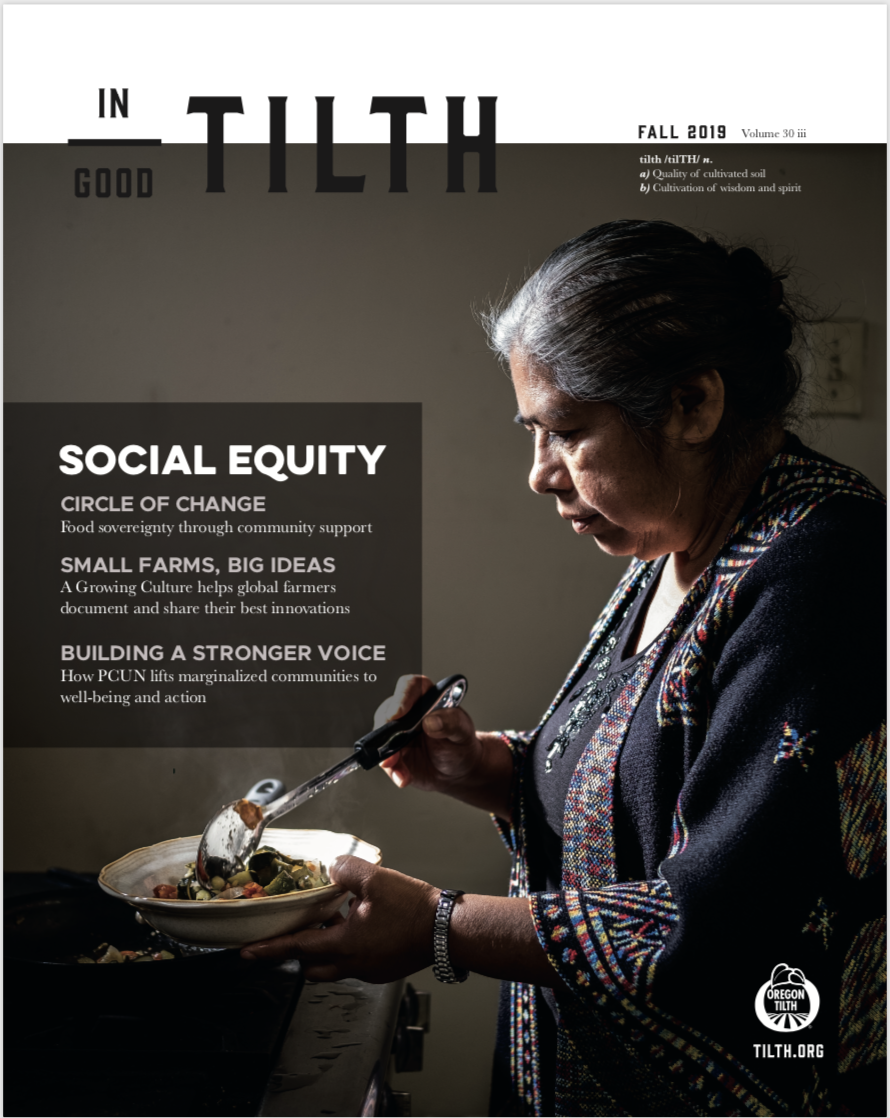Time. Knowledge. Money. For many, making the switch to organic agriculture is simply not feasible. The need for better support, including innovative policy solutions, is imperative in the movement to meet demands for more organic production in the United States.
The National Sustainable Agriculture Coalition (NSAC) sees a major opportunity to support organic transition through expansion and improvement of key policies and programs in the 2018 Farm Bill. Member organizations — Oregon Tilth is a represented member and serves on key committees — and coordination with the Organic Farming Research Foundation have helped NSAC identify, develop and advocate for critical policies that focus on transitional support.
Barriers to organic transition are often rooted in two major areas: economic and systemic. Whether lacking access to financing opportunities or navigating the new challenges of certification, policy solutions must be comprehensive and diversified to meet the unique needs of transitioning farmers and ranchers.
Opportunities to improve and expand existing support for transition
The USDA currently offers several programs that support transitioning producers, providing a series of bridges to farmers and ranchers at key steps throughout the process.
The Environmental Quality Incentives Program (EQIP) Organic Initiative, administered through USDA’s Natural Resources Conservation Service (NRCS), has shown enormous potential to support the adoption of critical conservation activities during the transition to organic production. Establishment of buffer strips, cover crops, pollinator habitat as well as practices around nutrient and pest management all meet multiple goals that support farm productivity as well as broader conservation benefits for whole communities. Unfortunately, participation by organic and transitioning farmers in EQIP has declined more than 75 percent between 2009-2016. The next Farm Bill offers a chance to increase participation, in particular with focus on targeting conservation assistance for transitioning producers. However, it is clear that EQIP is not enough on its own to mitigate all of the barriers facing new organic farmers and ranchers. Additional focus will need to be placed on the Conservation Stewardship Program (CSP) another financial assistance program within NRCS — in order to provide it with a strong statutory organic transition mandate.
Risk management tools such as crop insurance can afford transitioning producers protection from revenue losses and price volatility. The 2014 Farm Bill required the Risk Management Agency (RMA) to complete all organic price elections — the set price for what the established value of the crop should have been sold for — by 2015, but it is still unfinished. The RMA has issued more than 40 organic price elections to date and additional funding should help obtain more price data for organic production.
In addition, a few organic farmers have tried the new Whole Farm Revenue Protection program, which insures all production and enterprises on a farm rather than a single crop. The program is well-suited and attractive for highly-diversified organic farms. Meanwhile, other organic (and some transitional) producers are using the Contract Price Addendum (CPA) to insure their crop at a contract price. There have been instances where the contract price exceeds the cap on the amount of the premium over the conventional price that RMA has established. Further support for farmers transitioning to organic production requires the next iteration of the farm bill to create ease of access to a host of risk management products, while also advocating for completion of crop insurance price elections and revision of CPA pricing factors.
Additionally, there is an opportunity to improve USDA’s National Organic Certification Cost Share Program to enable farmers that obtain transitional certification to also receive cost share funding to support the certification process during the mandatory three-year wait period. The USDA’s Cost Share Program and Agricultural Management Assistance Cost Share Program help farmers recoup up to 75 percent of annual certification costs for a total of up to $750 per scope of certification (crop, livestock, wild harvest or handling). Further exploration and interest in the growth of transitional certification programs should see cost share programs be tailored to allow funding for these programs preceding organic certification.
Policies that encourage and support organic transition
Existing federal programs and policies that support organic transition can be expanded and improved to ease the transition process. Furthermore, we need policies that provide financial support for transitioning producers during the riskiest period between transition and organic certification where costs are high but yields are lower and premiums are still out of reach.
While critical, financial incentives are not the end all be all for a successful transition to organic production. Farmers encounter challenges preceding, during and after transition simply from operating a new farm management system. From new production methods to weed and pest pressures to recordkeeping and equipment modifications, transitioning producers are faced with changes and obstacles unique to organic systems.
Beyond the farm, any expansion of domestic organic production requires support, education and resources for the infrastructure behind organic agriculture. Storage. Processing. Veterinarians. Distribution. An entire sector must be prepared and in place to work in tandem with a network of farms in order to facilitate delivery and distribution of organic crop and livestock products to the very places, processors and people that need them.
NSAC believes a holistic transition assistance program should include technical assistance, mentorship, business planning and training to give transitioning producers the knowledge and support needed for success. Working in tandem with financial assistance programs, transition support programs would offer producers the ability to develop a Conservation Plan through NRCS, participate in a mentorship program during the transition period, enroll in a farm business course and access related training opportunities.
There is little question that successful implementation of existing policies and programs is rooted in reaching target audiences. The rollout of “organic points of contact” at the NRCS and Farm Service Agency enables states to provide resources and knowledge specifically tailored to organic producers’ particular needs and production systems.
Field-level organic champions in each state with NRCS are tasked with improving capacity in assisting organic and transitioning-to-organic producers. A vital resource, staff will help to expand field-level knowledge, resources and tools as central in overall provision of organic conservation support to farmers and ranchers. NSAC, Oregon Tilth and our member organizations will advocate for policy opportunities in the next farm bill that galvanize transition, while also encouraging producer participation in existing programs that help lay the groundwork for a successful transition over time. Our work in 2017 will be to connect producers with programs and each other to establish new and expanded policies for organic transition.



















